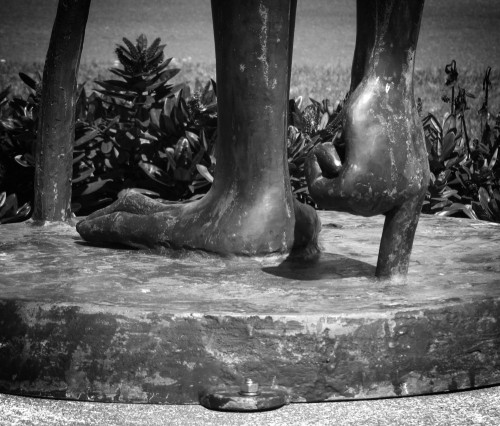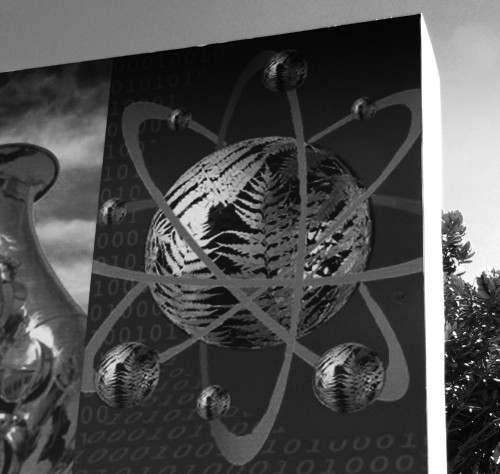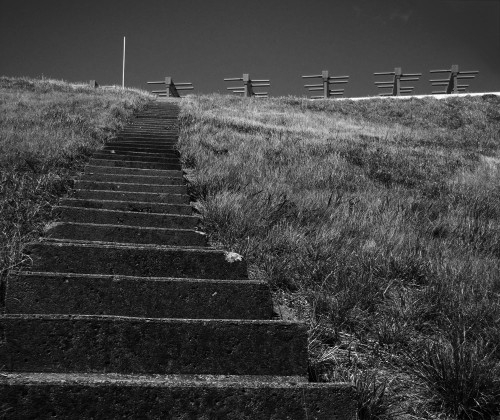Notional Significance: Takeoff
Regardless, I dash across the traffic to investigate the curious figure inhabiting the centre of the roundabout. She’s a sculpture by Paul Dibble, who appears to be making a career of roundabout memorials (together with the New Zealand War Memorial marooned on the traffic island of Hyde Park Corner), and while the inscription on her cheek reads “Pacifica 2000”, her official title is “Lady Down Under”. That, presumably, is why her one visible arm (and one of her three feet) points downward, plunging an index finger into the earth. Perhaps somewhere beside the Autovia de Castila there’s a bronze fingertip poking up from the earth at a bemused Spaniard. It’s odd that an airport company so keen on being “world class” should draw attention to our antipodean status: Europeans are on top, the true inhabitants of the right-way-up globe; and we’re down under, the rumoured, impossible antichthones.
But the mixture of aviation and entertainment can be a risky one. A fundraising pageant for the Macgregor Memorial Fund (“Mad Mac” Macgregor, ex-WWI flying ace, died after clipping an anemometer pole at Rongotai) went pear-shaped when the famed daredevil parachutist “Scotty” Fraser dared the devil once too often and reached terminal velocity in the shallows of the Bay. I haven’t heard of any Fraser Memorial Spectacular: perhaps they didn’t want to push their luck.
The wind is getting up as I make my way between barbed wire and the hard-scraped edge of Rongotai Ridge, heading towards the end of the airport. At the next roundabout I turn away from the brutal gouge of the Miramar Cutting — just one of the more visible signs of a land constantly being sliced and priced, drained and contained — and walk beside the crisp slope of the runway’s northern end.
I crouch against the hurricane wire, pointing my camera skywards, hoping to catch one of those photos — you know the type — where a plane roars overhead just metres above me. Nothing. Still nothing. I settle for a couple of shots of the airport infrastructure (approach lights, windsocks, mysteriously bristling structures), and in the end I find their sculptural qualities more satisfying than the typical takeoff shot. Some of them rival the wind sculptures along the MEWS walkway for their abstract formal qualities.
My mind seems to be running off on a tangent, away from the road that I’m walking: perhaps it’s because I’m struggling to find a connection between the location and the figure commemorated. There are photos of Batten at Rongotai aerodrome, but it seems that neither she nor any of her famous feats had any real association with this city. The threads of national significance spin out across the globe, though they become tenuous with distance, and I may be reaching too hard to find a psychogeographical connection between Batten and the complementary industries of aviation and entertainment that suffuse this place.
It’s one of the dilemmas of the would-be psychogeographer: immerse oneself in the deep connections, or lose oneself in the sensations of the moment? The sun grows fiercer, but is countered by a northerly that is now firm enough to whip up whitecaps on Evans Bay. The sound of traffic is building, but still a discrete series of vehicles rather than a constant roar. On this side of the road, there is infrastructure, corroding industry and an attempt to claim an elusive hero; on the other, there’s a recreational walkway, a strip of salt-hardy planting and the wide-open bay. Ahead of me, there’s a long road winding its way across this ever-changing isthmus, the sandy umbilicus that joins Motu Kairangi to the former mainland.




Nice.
But: “anticthones” ? Really?
I promised not to get all Francophile, but that doesn’t mean I can’t sneak in some Greek (http://en.wikipedia.org/wiki/Antichthones). Looks like St Augustine wouldn’t have beleieved in us.